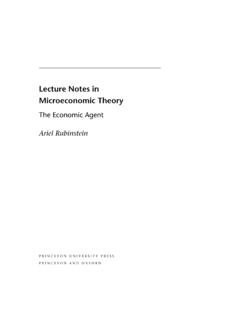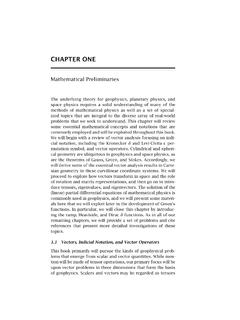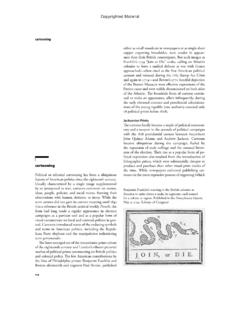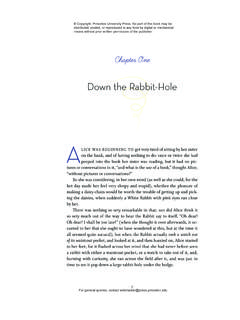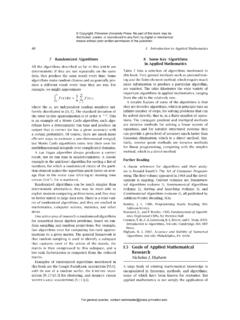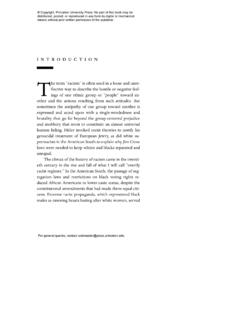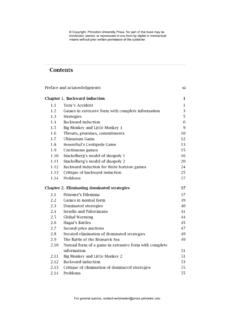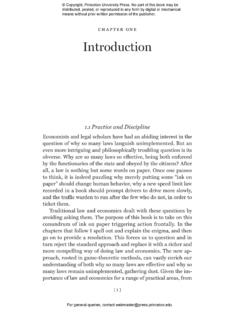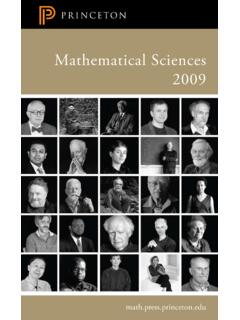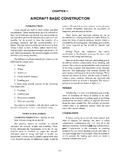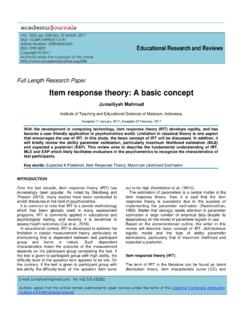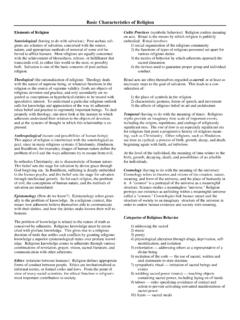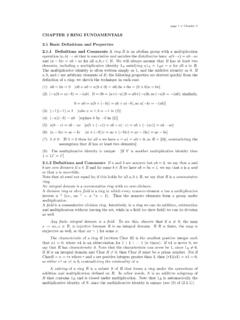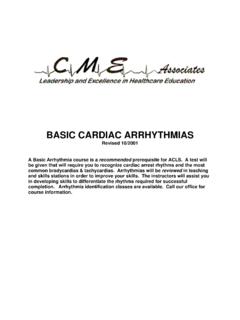Transcription of Basic Elasticity and viscoelasticity - Princeton University
1 Copyright, Princeton University Press. No part of this book may be distributed, posted, or reproduced in any form by digital or mechanical means without prior written permission of the publisher chapter one . Basic Elasticity and viscoelasticity In the physically stressful environment there are three ways in which a material can respond to external forces. It can add the load directly onto the forces that hold the constituent atoms or molecules together, as occurs in simple crystalline (includ- ing polymeric crystalline) and ceramic materials such materials are typically very rigid; or it can feed the energy into large changes in shape (the main mechanism in noncrystalline polymers) and flow away from the force to deform either semiper- manently (as with viscoelastic materials) or permanently (as with plastic materials).
2 Hookean Materials and Short- Range Forces The first class of materials is exemplified among biological materials by bone and shell (chapter 6), by the cellulose of plant cell walls (chapter 3), by the cell walls of diatoms, by the crystalline parts of a silk thread (chapter 2), and by the chitin of arthropod skeletons (chapter 5). All these materials have a well- ordered and tightly bonded structure and so broadly fall into the same class of material as metals and glasses. What happens when such materials are loaded, as when a muscle pulls on a bone, or when a shark crunches its way through its victim's leg? In a material at equilibrium, in the unloaded state, the distance between adjacent atoms is to nm.
3 At this interatomic distance the forces of repulsion between two adjacent atoms balance the forces of attraction. When the material is stretched or compressed the atoms are forced out of their equilibrium positions and are either parted or brought together until the forces generated between them, either of attrac- tion or repulsion, respectively, balance the external force (figure ). Note that the line is nearly straight for a fair distance on either side of the origin and that it eventu- ally curves on the compression side (the repulsion forces obey an inverse square law). and on the extension side. With most stiff materials the extension or compression is limited by other factors (see section ) to less than 10% of the bond length, fre- quently less, so that the relationship between force and distance is essentially linear.
4 When the load is removed, the interatomic forces restore the atoms to their original equilibrium positions. It is a fairly simple exercise to extend this relationship to a material such as a crys- tal of hydroxyapatite in a bone. This crystal consists of a large number of atoms held together by bonds. The behavior of the entire crystal in response to the force is the summed responses of the individual bonds. Thus one arrives at the phenomenon de- scribed by Hooke as ut tensio, sic vis, as the extension, so the force. In other words, Copyright, Princeton University Press. No part of this book may be distributed, posted, or reproduced in any form by digital or mechanical means without prior written permission of the publisher 2 1 Basic Elasticity AND viscoelasticity .
5 Figure Stress strain curve at the atomic level for a perfect material. The origin represents the equilibrium interatomic distance. On either side of the origin the curve is nearly straight. extension and force are directly and simply proportional to each other, and this rela- tionship is a direct outcome of the behavior of the interatomic bond. However, when one is dealing with a piece of material it is obvious that measurements cannot conve- niently be made of the interatomic distance (though they have been made using X- ray diffraction, which confirms the following). What is actually measured is the increase in length of the whole sample or a part of the sample (making the verifiable assump- tion that in a homogeneous material one part will deform as much as the next).
6 This difference is then expressed as a function of the starting length called the strain, f. Strain can be expressed in a number of ways, each offering certain advantages and insights into the processes of deformation. The most commonly encountered form is conventional, nominal, engineering, or Cauchy strain, which is the increase in length per unit starting length: Dl fC = . [Eq. ]. L0. This estimate of extension works well if the material is extended by no more than a tenth of its starting length. Strain is expressed either (as in this text) as a number ( , ) or as a percentage ( , ). The force acting on each bond is a function of the number of bonds available to share the load.
7 Thus if the area over which the force acts is doubled, then the load carried by each bond will be halved. It is therefore important, if one is to bring the data to the (notionally) irreducible level of the atomic bond, to express the force as a function of the number of bonds that are responding to it. In practice this means expressing the force as force divided by the area across which the force is acting, which is called the stress, v: f v= . [Eq. ]. A0. However, just as with strain, this simple equation is suitable only for small extensions. In SI units, the force is expressed in newtons (a function of mass and the accelera- tion due to gravity: one newton is approximately the force due to 100 g, which can be produced by an average apple falling under the influence of gravity), the area in Copyright, Princeton University Press.
8 No part of this book may be distributed, posted, or reproduced in any form by digital or mechanical means without prior written permission of the publisher HOOKEAN MATERIALS AND SHORT- RANGE FORCES 3. square meters. One newton acting over an area of one square meter is a pascal (Pa). Other units are in use in many parts of the world. For instance, in the United States the unit of force is the dyne (the force exerted by one gram under the influence of gravity), and the unit of area is the square centimeter. One dyne per square centimeter is one hundred- thousandth (10 5) of a pascal. Traditional engineers in Britain often use pounds and square inches as their measures of force and area.
9 The slope of the straight, or Hookean, part of the curve in figure is characteris- tic of the bond type and is a function of the energy of the bond. For the same reason, the ratio of stress to strain is a characteristic of a material. This ratio is the stiffness or Young's modulus, E: v E= . [Eq. ]. f The units of E are the same as for stress, since strain is a pure number. Graphs show- ing the relationship between stress and strain are conveniently plotted with the strain axis horizontal and the stress axis vertical, irrespective of whether the relationship was determined by stretching the test piece in a machine and recording the developed forces or by hanging masses onto the test piece and recording the extension.
10 Do not be surprised if it takes a long time for the mental distinctions between stress and strain to become totally clear. Not only are the concepts surprisingly difficult to disentangle, but the confusion is compounded by their uncritical use in everyday speech. One other characteristic of Hookean materials is that they are elastic. That is to say, they can be deformed (within limits) and will return to their original shape almost immediately after the force is removed (almost immediately because the stress wave travels through the material at the speed of sound in that material. Thus when you pull on the brake lever of your bicycle, the brake blocks begin to move a short time later, the time dependent partly on the speed of sound in the steel cable and partly on the length of the cable).
